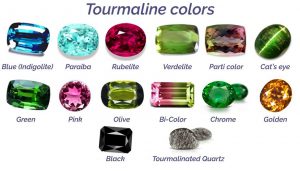Tourmaline
Mineral: Silicate
Hardness: 7-7.5
Birthstone: October, Anniversary: 8th

The name tourmaline is derived from the Sinhalese (Sri Lankan) word tourmali, meaning “gemstone.” Often mistaken for more renowned gem varieties such as emerald, sapphire and ruby, Tourmaline is not a single mineral, but a group of several closely related minerals in the silicate family. The most well know tourmaline species are Elbaite, Schorl and Dravite. Chromdravite, Liddicoatite and Uvite are lesser known species.
Elbaite Tourmaline, one of the most colorful of all gem species and a favorite of gem connoisseurs, is named after the island of Elba, Italy, where it was first discovered. Elbaite crystals have been found across the globe from California to Myanmar, though the largest deposits are in Brazil and Africa. Major varieties include green Verdelite (common), pink or red Rubellite (rare), blue Indicolite (rare), yellow Canary (rare), colorless Achroite (rare) and bicolor Elbaite (usually pink and green), also called Watermelon Tourmaline.
The rarest variety of Elbaite is Cuprian tourmaline, commonly known as Paraiba Tourmaline. This variety, found and named after where it was discovered in Paraiba, Brazil, is different from other varieties of tourmaline. Paraiba Tourmaline has copper as part of its chemical composition which creates an intensely bright, “neon” quality in the color of the crystal. Paraiba Tourmalines are laboriously hand excavated and it is said that the best areas for sourcing them are depleted, making them an extremely rare and costly gemstone.
According to Egyptian legend, as tourmaline makes its long journey to the surface from the center of the Earth, it travels over a rainbow and gathers all of the rainbow’s colors. Because of this, tourmalines are referred as ‘the gemstone of the rainbow.’
For centuries, various cultures have had different beliefs about what virtues the tourmaline can bring to the wearer and each species has different metaphysical benefits. In general, tourmaline is said to aid in understanding oneself and others, promoting self confidence and diminishing fears. The gem was also highly valued by alchemists who, perhaps because of its pyroelectric qualities (naturally electrically polarized so generate electricity when heated), believed it to be related to the philosopher’s stone.

